Mykolaiv
Mykolaiv spreads out around the silver mirror of the Southern Bug River. The bridge over the Bug is raised, lowered, raised again. Every day, buses full of women and children depart for Odesa, which remains safe for now, though some flee farther still, to Moldova or to those parts of Ukraine not yet subsumed by war.
There are Russian divisions twelve miles to the north and east. They are shelling the outskirts of town.
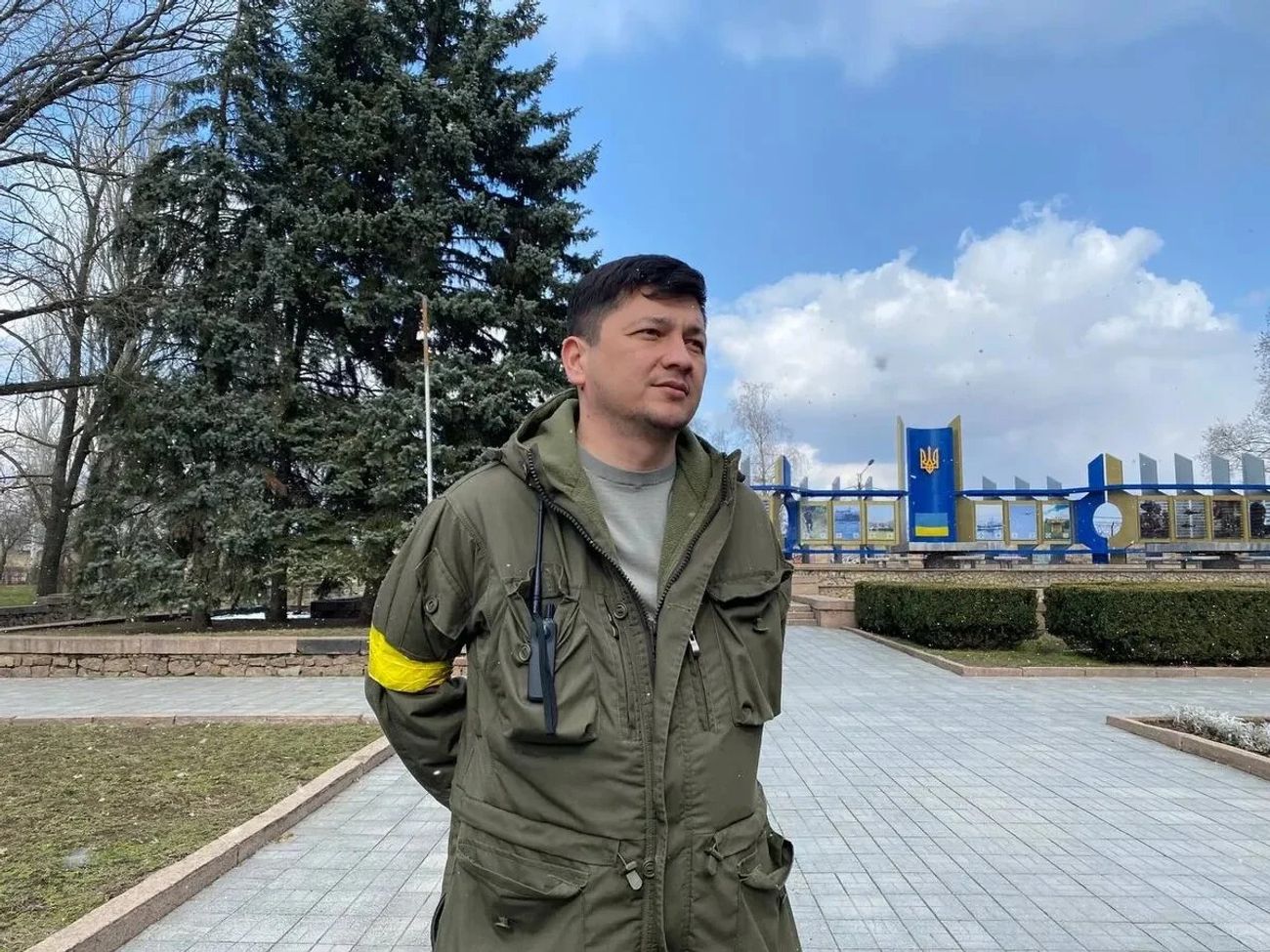
Governor Vitaly Kim
Elena Kostyuchenko / Novaya Gazeta
Mykolaiv operates in blackout mode, no lights allowed after nightfall. The city administration has warned that a single individual’s failure to comply will result in the electricity being cut off for their whole building. Only the grocery stores and pharmacies remain open. Schools and day cares have been on break since the war began; no one wants to separate children from the adults. Many of the bus routes have been canceled; some of the buses have been requisitioned by the army and others deployed in the evacuation.
There are heaps of car tires sitting at the city’s intersections, ready to be ignited when Russian troops enter the city. Some still bear traces of paint from when they served as decorative borders for municipal flower beds. “One useful thing about the war,” said the mayor, “is that at least we’ll get rid of the rubber swans.”
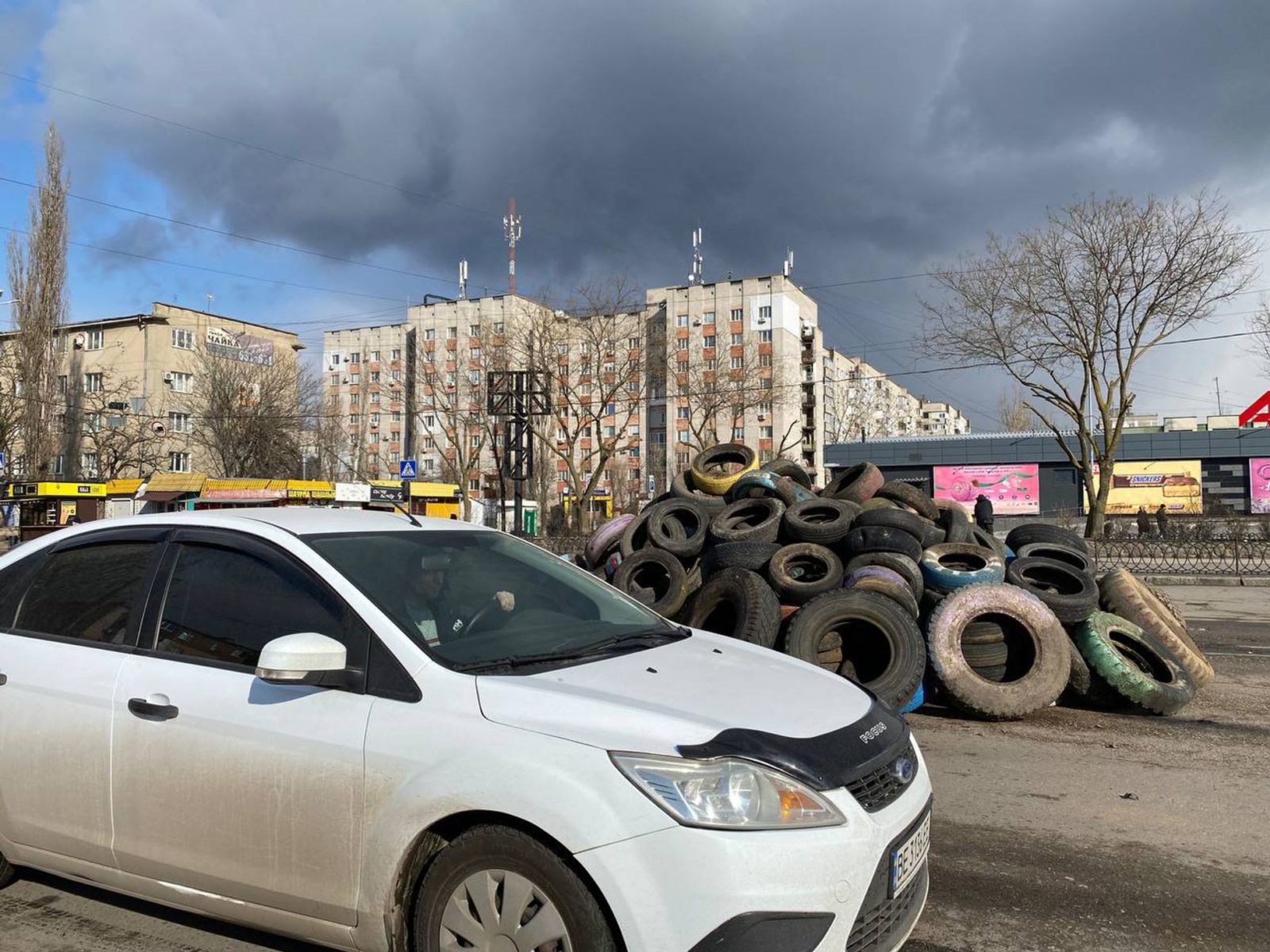
Nikolaev
Elena Kostyuchenko / Novaya Gazeta
The lines for humanitarian aid packages are orderly: grains, tinned food, butter.
Everyday life takes place between air raids. The trauma center has been converted into a field hospital. Patients are evacuated as soon as their surgeries are completed and their wounds are patched up. Beds are then quickly cleared for incoming patients. The medical staff lives on-site and have done so for the past two weeks, since the war began.
Humanitarian aid comes through Odessa. The bigger city watches Mykolaiv with awe: Odessans believe that Mykolaiv is the only reason Odessa has not yet been besieged.
“Mykolaiv is partially surrounded,” says Yaroslav Chepurnoi, press officer for the Seventy-ninth Brigade. “There are seventeen Russian battalion tactical groups [BTGs] positioned around town,” he says. “Say each one consists of approximately a thousand men: that means seventeen thousand soldiers and fifteen hundred units of military tech—weapons, equipment, vehicles. We don’t know their command center’s plans, obviously; we can only assume that some of these BTGs will go north, possibly to Kryvyi Rih. But some of them will stay back and storm the city. We know that the Russian command has been ordered to take Mykolaiv, that it’s been ordered to take Odessa, and probably also to punch a land corridor to Pridnestrovie. So we are building up our defenses. Each day that goes by while they wait to attack Mykolaiv we use to build up our defenses.
“The Russian troops attacked a few times already. Four times, I think. The first three were just to gather intelligence. They came in small numbers, and we repelled them, blew up their vehicles. . . But March 7 was a proper attack, with rockets and tornado missiles at first, then they threw two BTGs at us.
“Here’s something interesting. They had plenty of weapons and carriers, but all it took for them to turn back and retreat was our blowing up a few tanks and a couple of armored vehicles. As soon as they took a bit of damage, insignificant damage, they turned around and retreated. We were surprised, frankly. When you launch an attack with tanks and armored vehicles, you expect to lose a few of them in the course of fighting. That shouldn’t prevent you from pushing on.
“According to the official count, there are three thousand captured soldiers across Ukraine. I trust those numbers. Even here, there are dozens and dozens. A couple days ago, we had twelve people surrender after some fighting. The fighting was over, even.
“They’re shelling the city with Grads and Hurricanes and Tornadoes. Grads may be only 122 millimeters, but Hurricanes are 240 millimeters and Tornadoes are 320: these are all multiple-rocket launchers. At first they targeted military installations. On February 24, they shelled our military airbase at Kulbakino, but our planes were already gone, so no dice. On the evening of the fourth, they targeted the railway station and the fuel storage tanks. Then the bread factory—I mean, God knows what they’re thinking. . . . And then, on the sixth and the seventh especially, they started heavily shelling the military units, as well as just residential areas. They’ve already hit the water treatment plants on the outskirts of the city a few times, so we figure they’re trying to mess up the water supply for the civilians. They’ve stationed artillery in the towns and villages between Mykolaiv and Kherson, that’s where they’re launching from.”
Shells rain down on Khersonskaya Street. This is Balabanovka, a residential neighborhood on the southernmost tip of the Korabelnyi district. The homes are so badly damaged they look half built. Slate tiles blown off the side of a fence, roofs sliding down into craters. The streets between the houses are strewn with the detritus of everyday life. A wall has shattered into bricks, though a little sign with the building number—22—survived. There’s no glass left in the windows, which makes the buildings look abandoned. A crumpled Gazelle van sits stowed behind a green gate.
Beyond the gate, a vegetable garden, the earth recently plowed. A cherry tree, strafed to the ground, its branches scattered across the warm earth. There are three gaping holes in the attic roof.
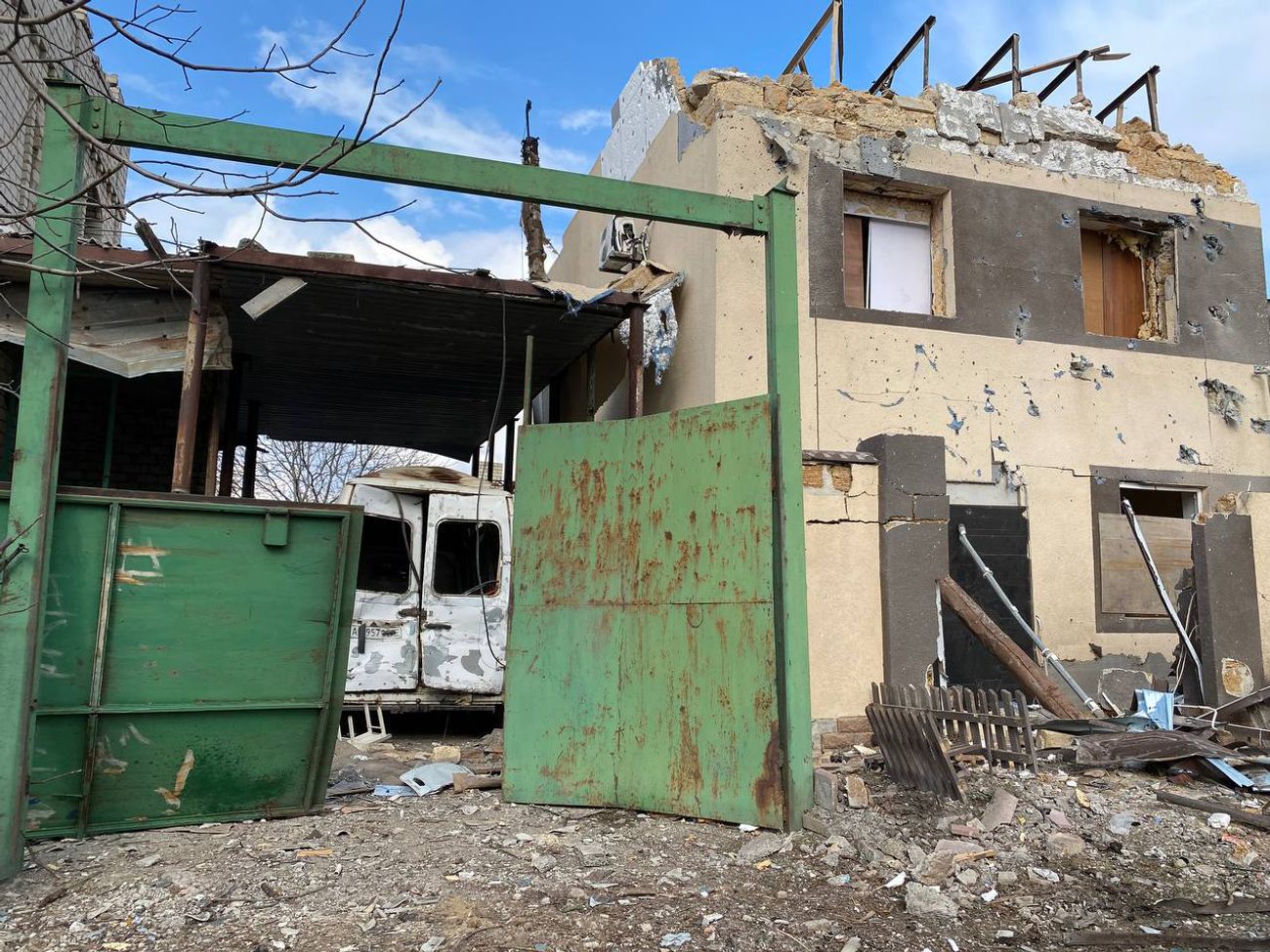
Consequences of shelling, Nikolaev
Elena Kostyuchenko / Novaya Gazeta

Sasha with a shell fragment in his hands
Elena Kostyuchenko / Novaya Gazeta
Sasha is up on a ladder, clearing the shattered slate tiles off the roof. He seems not to notice the tears running down his own face.
“First the shelling. A big whoosh over the wheat, all our windows blew out. Then it seemed to get quiet. My wife was on the porch, I was in the kitchen. She sits down. I take a look out the window and see these two airplanes from who knows where, black like the stealth ones. My wife fell over, and then rat-a-tat-tat! Some kind of white smoke. I threw myself over my wife and we started crawling. I’ve been picking up all the shards. Look how sharp they are, you can cut a person in half with that.”
His wife, Nadya, sits with her palms on her knees. “This is where I sat down. I was sitting right here. I’m sitting here, and there’s no sound at all. No sound for me to be afraid of. These two airplanes, they were scary, black or dark gray, but I didn’t even move from where I was sitting. I thought, ‘They’re not going to bomb civilians.’ And right at that second they started in on the ceiling. . . . I can’t tell you how terrifying it was. . . . Look at the gate, all the holes. Another moment, and that would have been me. I’m still in shock, I still can’t feel my legs. I’m terrified. Because the idea of leaving is terrifying, too. You still have to make it somewhere. This family I saw on the news, they were fleeing and they got caught in an air raid. The children died, and the parents, everyone.”
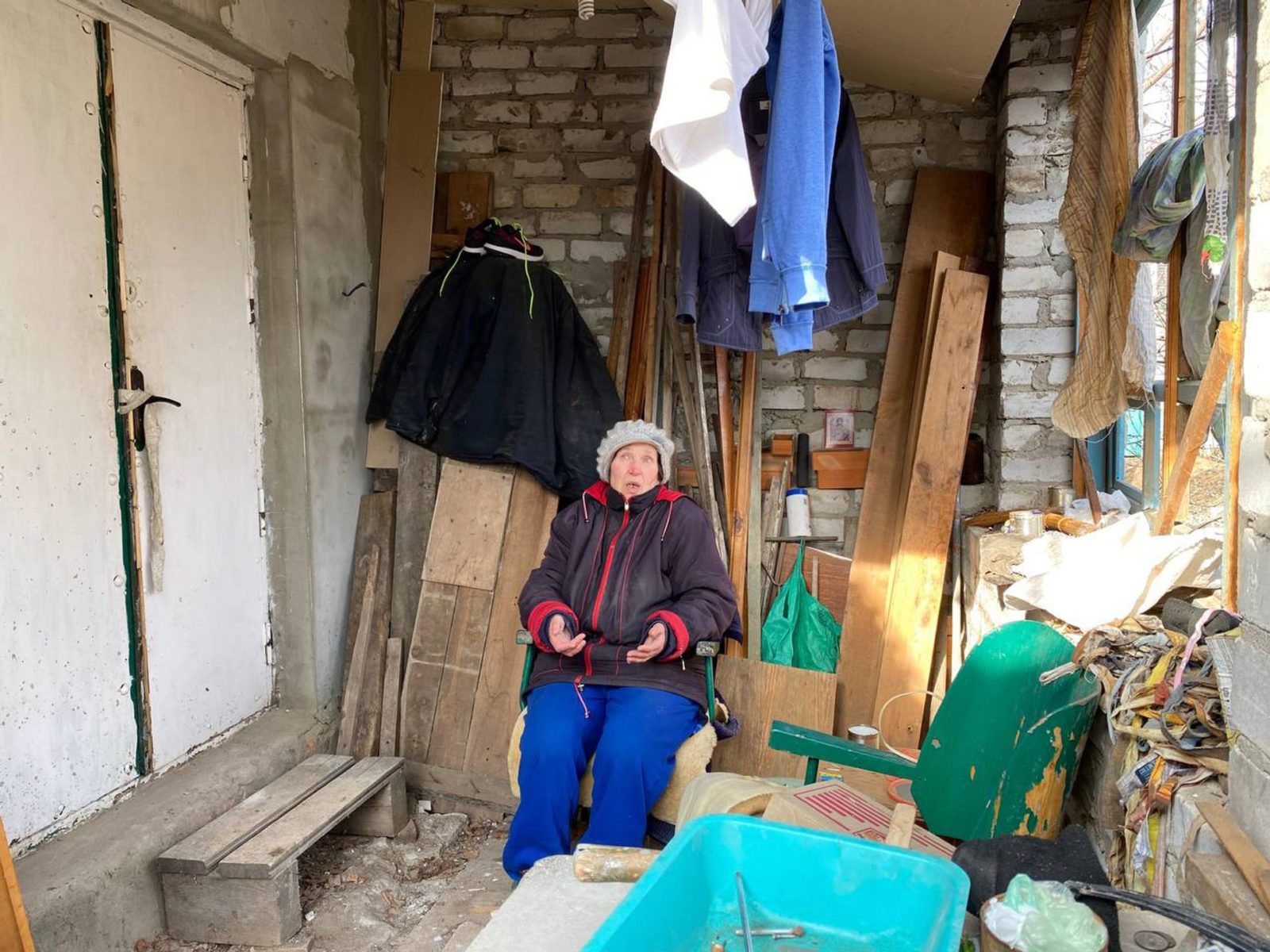
Nadia, Sasha’s wife
Elena Kostyuchenko / Novaya Gazeta
The Mykolaiv orphanage was evacuated immediately after the war began. There were ninety-three children living there, aged three to eighteen, all “social orphans,” children with living parents who cannot look after them. The children were taken to Antonovka, a village forty-one miles northwest. Five days ago, Russian troops assembled next to the village. On March 8, at 9:20 a.m., the troops fired on a car driving orphanage staff down the Kirovograd highway. Three women were killed.
Anatoly Geraschenko was the driver. He shifts anxiously from foot to foot. There’s a piece of shrapnel lodged in his right leg. “The surgeon said that they’ll operate if it starts to rot,” he says, but for now they’ve left it alone. Masha stays close to her father. One of her eyes is blue, the other one brown. “I’ve got three sons and two daughters,” Anatoly says proudly. He’s visibly shaking now, “It’s cold,” he says.
This was his third trip to Antonovka. He wouldn’t accept any money, only enough to cover the gas. He had stuck a red cross made of packing tape to his windshield. His van, a Mercedes Sprinter, burned along with the bodies inside.
“We made it past all the checkpoints, showing our passports every time. I had six women with me, and two in the back. At one of the checkpoints, they said something had gone down in the night. They shouldn’t have let us through!
“There was no oncoming traffic, just empty lanes. We made it about twenty-five kilometers. My vision’s not great, but two hundred and fifty meters out, the women spotted something, they tell me there’s something up ahead, something military. I said, ‘Ladies, what do we want to do?’ I slowed down. Then came the machine gun fire, I didn’t hear it or see anything. I only saw the gravel spraying out in front of me. Now I know why.
“I can’t remember exactly how they shot at us. Either I’d stopped completely by then, or maybe the van was still rolling a little. I didn’t see the blast, I only felt something shredding, dropping off of the van. A burst of light at my feet. I got out of the van, and they run over to me with their rifles. I’m lying facedown on the asphalt, screaming: ‘There are women inside! Women inside!’
“The Russians opened the back door—there were four more people in there. The women came out into the field. They ran over to them shouting, ‘Drop your phones!’ The women, four of them, all tossed their phones on the ground by the soldiers’ feet. I threw mine into the grass. I had a small one on me, in my pocket. My smartphone was still in the car, on the dashboard.
“When I go back to the van, it’s gone. I start looking for it. There was a woman sitting by the door—she had no face left. Just her guts out. Her finger was lying on the running board. Her face was gone! It was gone! And the woman sitting right behind me was dead, too, but her I didn’t see.
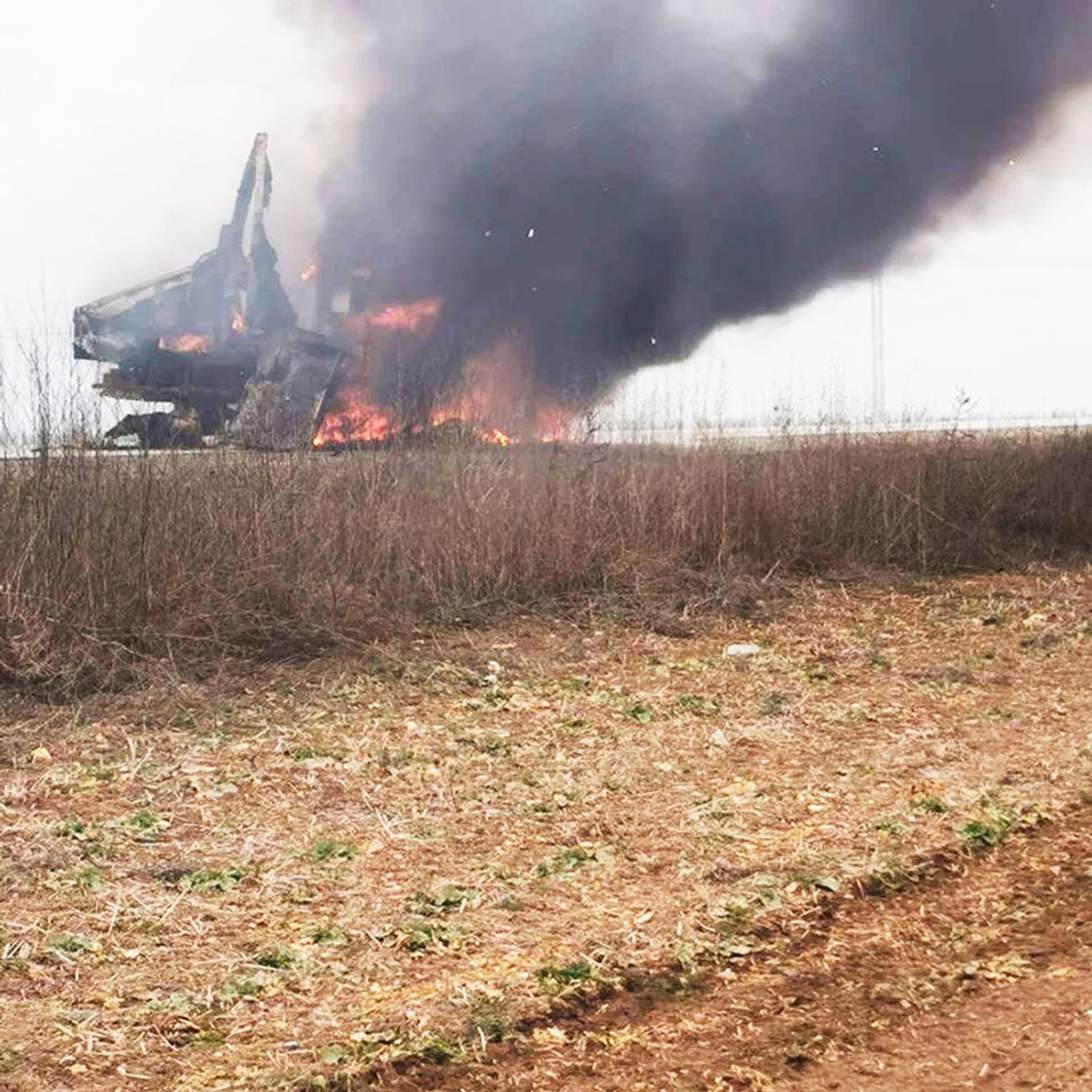
Burning car after shelling
Archive of Anatoly Gerashchenko
“The Russians are saying: ‘We warned you! We gave you a warning round.’ But I’m no soldier! Warning rounds aren’t the kind of thing I encounter every day. One of the women was wounded in the shoulder. They lifted her up onto her feet. One of the soldiers, a Yakut, or maybe he was a Buryat, bandaged her wound. The other one was very young, a kid, really. He had the same sunglasses as me. I remember his face. My leg was bleeding from all the shrapnel. This kid, he drew back when he saw me. Maybe he got scared or something. I said to him, ‘How do we get out of here?’ He says, ‘Take the fields. All the road signs have been taken down.’ I said, ‘We are going to walk on the road. If any of your men are up ahead, you tell them.’ They said, ‘We’ve informed them already.’
“They seemed completely indifferent, the Russians. They didn’t even care that the car was on fire, that there might still be people inside. I said to them, ‘Help me put it out, at least!’ They just stood there.
“I saw someone in the back lying there when the van first stared to burn. I got inside. It was this woman, her husband had seen her off, kissed her goodbye. I pulled her out—another woman helped me. We laid her out on the road and her back was all bare. I’d been dragging her by her jacket. Her back was shredded with shrapnel. I didn’t check her pulse or anything. Her husband called me today. I told him, ‘She didn’t burn, I pulled her out. . . . She’s still lying there.’
“There were two bodies left inside, they burned with the van. That car really burned. My birthday is November 11. And now it’s March 8, too.”
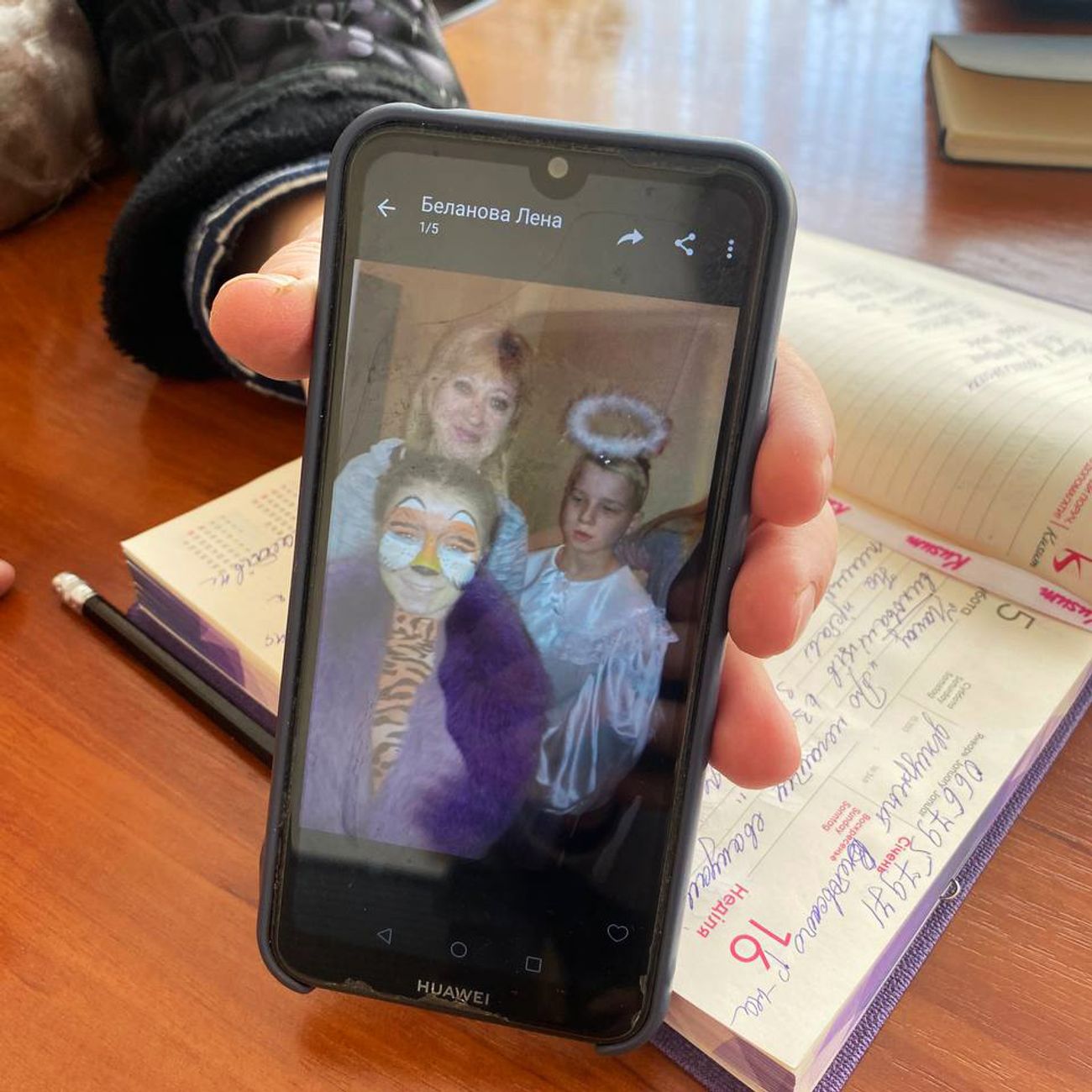
Principal Svetlana Klyuiko shows photos of the dead teachers. In the photo – Elena Alexandrovna Batygina
Elena Kostyuchenko / Novaya Gazeta
The three women killed were Natalia Mikhailova, Elena Batygina, and Valentina Vidyuschenko. The director of the orphanage, Svetlana Kluyko, tells me about each one of them: “Natalia Mikhailova, she’s been with us since 2014, a teacher. She used to work at a special-needs school so she was very experienced. She was the best sort of human being, kindness personified. If only there were more like her. She loved children, she was so wise, so good with her hands. All of my staff are excellent, but she in particular found a way to get on with everyone. She looked after the older boys. She would have been fifty on May 4. We were going to throw her a party. Elena Batygina took care of the little ones, dressing and changing them. Her children were always dressed so nicely. She had a big stock of different outfits, and party dresses. The children loved her, too. She was so kind. Twenty years with the orphanage. She was sixty-four. Valentina Vidyuschenko, she hadn’t been with us long. It was her second year as a teacher’s assistant. She was working with the new intakes, one of the most difficult groups. . . . When the children first come to us, they’re in tears. . . . They’ve been dropped off somewhere strange, it’s so stressful for them. She was one of the first people they met. She helped them wash, dressed them, changed them, talked to them, made them feel better. That’s the sort of people they killed. The children were inconsolable. They had been waiting for the teachers to come, we’d told them that they were on their way. The children screamed and screamed and wouldn’t stop.”
It was not possible to collect the bodies—or rather, what was left of the bodies: “We can’t get to them.” They remain where they were, fifteen and a half miles from the nearest Ukrainian checkpoint.
The wounded are in the Mykolaiv hospital: Anna Smetana, another teaching assistant, and Elena Belanova, a psychologist. The others, Galina Lytkina and Natalia Vedeneeva, have also been hospitalized, with “severe psychological trauma.”
Ninety-three children and ten teachers await evacuation farther into Ukraine in a village encircled by Russian troops.
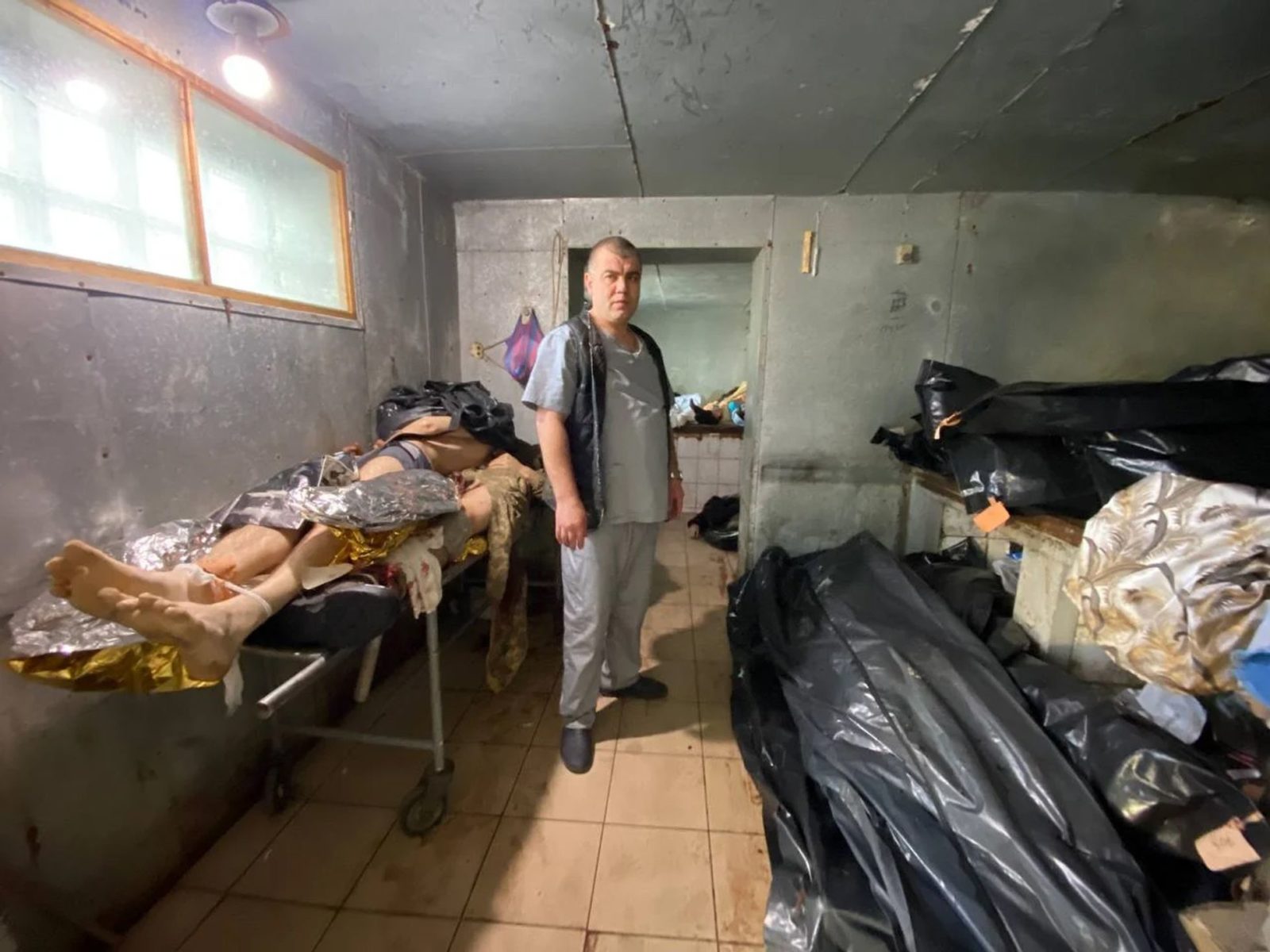
Orderly in the mortuary bureau of forensic examination
Elena Kostyuchenko / Novaya Gazeta
All the dead pass through the office of the regional medical examiner. According to Olga Deryugina, its head, since the start of the war they have processed over sixty bodies of Ukrainian soldiers and more than thirty civilians. When I ask for the exact numbers, she replies: “What’s the point? New ones arrive every day.” Each body is examined by a team of investigators preparing to file documents with the International Criminal Court at the Hague.
“We’ve never had so many bodies at once. Shrapnel, bullet wounds, bomb blasts . . . shrapnel, mostly. We’ve had two corpses with unexploded munitions, the bomb-disposal technicians had to come out to defuse the bodies.”
“That’s right, there was an unexploded ordnance attached to the body, I removed it myself,” says Yuri Aleksandrovich Zolotarev, one of the medical examiners. “It hadn’t gone off because the fuse was damaged. I pulled out the casing to give to the bomb-disposal experts so that they could examine it. I told the women to stand back. . . . These had been soldiers. . . . I pulled it out very carefully and handed it over to the bomb-disposal technician. The fins were up inside the rib cage, but the fuse was inside the stomach—it hadn’t blown up because the stomach walls are too soft. That was when they were shelling Ochakovo—these were mostly bodies from there. . . . The other guy, it was only a part of an ordnance. When the women came to identify them, the wives, the way they wailed, I haven’t heard anything like that in my twenty years on the job. I was in the Bosnian war—I never saw such savagery. Two of our soldiers I autopsied—it wasn’t enough that they finished them off with bullets, they also had to knife them in the back. . . . On March 6, two young guys went over to the aircraft repair facility, to try to torch it with Molotov cocktails. . . . The soldiers caught them, tied them up, shot them in the head, and then finished them off by stabbing them in the back. They had knife wounds, dagger wounds under the shoulder blade. It’s barbaric, taking the wounded and finishing them off like that.”
“First they shot them and then they finished them off?”
“I’ve been a medical examiner for twenty years! I know which of those wounds came first.”
The bodies are piled up in two sections of the cold storage. But there isn’t enough room in there, so the ones that have already been autopsied are stacked outside in the street, beside the wall. Eight of them, in black body bags. An outbuilding that was used as a shed before the war is now full of bodies, too—two rooms, each of them sixty-five feet across. There are bodies all over the floor. Five Russian soldiers lie in a corner. “We’re keeping them while it’s cold outside. Nobody knows who we should hand them over to, or how.
“These are all war fatalities, the burn victims are already body-bagged. . . . Step over them, don’t be scared. I’ve got some others here, too. Once we’ve worked them over, we have to pack them up in these black plastic bags, because, to be honest, there’s nowhere to put all the autopsied bodies, you’ve seen the state of the rooms.”
There are bare feet and feet still wearing shoes. Here is a scorched, blackened young man on his back, arms spread wide, a charred black mess for a face. Half of a human body, flesh fused with grass, a jacket covering the head, and a man’s hand hanging down from under the jacket. A naked man wrapped in a floral sheet. A Russian soldier with his hands behind his head; his camo jacket is riding up and you can see a clean undershirt and the yellow strip of his belly.
The bodies in the cold storage are stacked up in layers. Two girls lie one on top of the other. They are sisters. The older one is seventeen. All I can see in the heap of bodies is her hand, her slim, long fingers with neat pink nail polish. The younger girl is three years old and lies on top of her sister. She is blond. Her jaw has been tied shut with gauze, her hands tied together to rest on her stomach. Little red wounds from the shrapnel cover her body. The girl looks alive.
Arina Butym and Veronica Birykova. Same mother, different fathers. They came in on March 5, at five p.m. They’re from the Meshkovo-Pogorelovo village, Shevchenko Street.” Nikolai Chan-Chu-Mila is an orderly here. He doesn’t look at me when he speaks. “I’m their godfather. . . . I did their baptisms. We’re old friends. They brought the girls in during my shift. Of course I recognized them straightaway. I can’t describe what I went through when I first saw them.”
Dmitry Butym is the girls’ father. He waits on the other side of the fence, he’s taking their bodies home today. Deep red folds rim his eyes. “Vera was heating up food in the kitchen. Arina had gone out to play in the yard. They didn’t have a chance, either of them. The little one died instantly, a piece of shrapnel through the heart. The older one, they got her heart going for two minutes, but it wouldn’t beat on it own. Their mother is in the Dubki hospital, she has shrapnel in her thigh—it damaged things as it went through. You have to excuse me, all I can think about right now is burying my children.”
There’s a new body being brought in. The attendants are unwinding a striped bedsheet. It’s a man, the breathing tube still in his throat and his body flayed. Somebody tried to save him but couldn’t. He is left to lie in the yard.
Four men with dark roses are waiting for their colleague to be released to them. Igor was a security guard, a civilian. “That goddamn Tornado comes down, and that’s it.”

Elena Kostyuchenko / Novaya Gazeta
A body in camo trousers is carried out from the shed. The body is purple, with a wide gash where a face should be. Two men from the investigations unit bend over him. They take down a description of his clothes, remove his trousers, take a DNA sample by dipping a piece of gauze in his blood. One of them pokes his fingers into the crushed mess of the man’s mouth—they need to establish which of the skull bones are broken.
A light-haired woman wrapped in a black headscarf speaks: “My mother lived on the fifth floor. She couldn’t get down to the bomb shelter in the cellar. Her next door neighbors, they helped her, they were like family. She died in the morning, peacefully. As much as you can call it peaceful—she was on the bathroom floor, hiding from all this horror. The next day, at exactly the same time, a rocket hit the building next door and blew out all of her windows. But she was already gone by then. I think it was some kind of miracle, that she died peacefully on the Sunday. The next day she would have died in a state of terror. She was seventy-seven. I have a photo of the apartment, what was left of it, from the neighbors. This is the view from her window, the building next door that was hit. It was the next day, she wouldn’t have survived it. She died on Forgiveness Sunday. And on the seventh all of her windows burst. She would have been so frightened. If it had to happen, I’m glad it was on the sixth and not on the seventh. I’m so grateful. My mother was named Svetlana Nikolayevna. She was half Russian. Her husband, my dad, was born in Russia, in Krasnoyarsk. He was stationed here, that’s how they met. My maternal grandfather was from Kursk. We were a Russian-speaking family. We’re going to the cemetery now. My son is in Kyiv. My name is Oksana.”

Barracks of military unit A0224 after shelling
Elena Kostyuchenko / Novaya Gazeta
Army base A0224 is one of the two military installations at Mykolaiv that was hit by artillery fire. On March 7, at 5:15 a.m., the barracks were struck by a Caliber rocket. Nine dead, including five conscripts who had not yet seen fighting. Fourteen wounded. Two of the conscripts initially presumed missing in action were found several hours later—they had fled and hidden.
A chunk of a three-story building has been reduced to rubble. There’s a bunk bed still sitting on an intact bit of floor. Emergency responders dig through the rubble by hand. They work with the military personnel, passing the pieces up a human chain. They are searching for the body of the last missing man. His name was Stas. He was a native of Western Ukraine and had been drafted eight months ago.
Yaroslav, the press officer, had a lucky escape that night. He is squinting at the sun, his hands never not on his rifle. “They sounded the alarm at about five fifteen. I shot up and shouted, ‘Boys, everyone out!’ We were the first ones out of the barracks, we didn’t even put our boots on. . . . There were guys standing outside, and I told them to get inside. God forbid that they hit us with something, the shrapnel would go everywhere. . . . I started to go back inside. I ran back in and when I got to the second floor, maybe seven meters from me, I saw the tiles flying up, then a flash—fire. I saw fire. At five seventeen they hit us.
“I was knocked back by the blast. I covered my head with my arms. There was glass raining down on me. I try to turn on my . . . Fifteen seconds pass and I turn my flashlight on and I’m crawling. I can hear people screaming, a woman was screaming. I’m crawling and crawling, but I can’t feel the ground under me anymore. There is no ground. I hear the sergeant shouting, ‘Everybody outside!’ I managed to get back and started to run out. I had my rifle with me. Everybody I saw, whoever was left, I told them: ‘We have to get down to the shelter.’ And that’s how we made it out. Taras, Danila, some of the other guys, they were all buried under the rubble. There had been twenty-nine of us in the sleeping quarters.
“I don’t want to start cursing . . . but I’m not taking prisoners, not after this. And I don’t care about their parents or wives. I don’t feel any pity. I’m twenty years old, I was training to be a veterinarian, but I don’t have any pity left for anyone.”
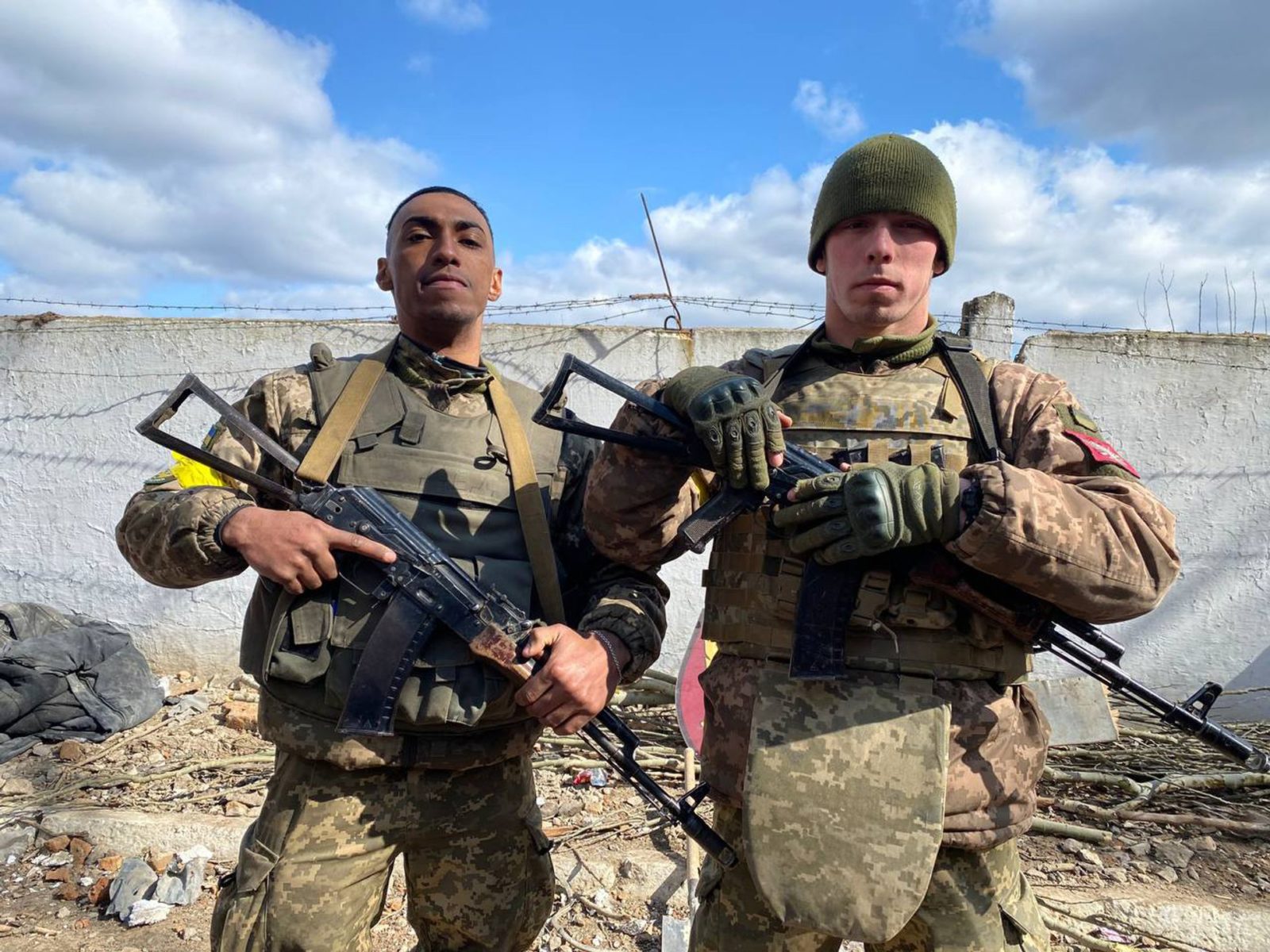
Anthony and Yaroslav
Elena Kostyuchenko / Novaya Gazeta
Somewhere up at the front lines, the Ukrainians have shot up a Tiger infantry mobility vehicle. Its Russian crew of four has surrendered. At HQ, they think that the Russians were doing reconnaissance, but those who were actually there think the Tiger was probably just lost.
Arthur has a black bandanna over his face. In his former life, he was a specialist in economic cybernetics. “There was a car driving up from the direction of Kherson. When it got here, I saw it was armored. They rolled down a window. I look inside: Russians, in uniform. I say, ‘Surrender.’ I cursed at them, too. The guy rolls the window back up before I could shoot. I started shooting out their tires. The car rolled for maybe another twenty seconds. Somebody threw a grenade and the car burst into flames. They didn’t want to come out at first. We smashed the windows in, and then they began to surrender.”
“Did you talk to them?”
“We tried not to. These terrifying warriors. All our guys were laughing their asses off. It was the usual bullshit: they thought that they were just doing military exercises, all of that crap. ‘I don’t even know where I am.’ Total bullshit, of course they know.”
They handed the prisoners over to the Security Service.
Someone has graffitied “Death to the enemies” on the dividing line in the middle of the road. The soldiers are warming up by the wood-burning stove. “Those Russians fucked up our spring.”
“I heard that it came from those towers,” says a soldier nicknamed the Actor. “A sniper or a machine gunner, I don’t know for sure. One bullet hit forty centimeters from my foot. After the third bullet, I finally clocked that they were aiming right at me.”
“Are you waiting for them to storm the city?”
“I’m waiting for all this fuckery to fuck back off. And I hope that the residents of the occupied territories are making plenty of Molotov cocktails. And I’d like to wish my daughter happiness. She’s three. I named her Maria.”
“My family stayed. My brother’s house is a little bigger than mine. We all live in the same village—my brother, our mother, and me. My brother is older, so he’s the head of the family, you know how it goes. His job is protecting the women and children, my job is to be here. I was in Varvarovka when they shelled the Kulbakino air base, working at a shipbuilding plant. My uncle woke me up at six thirty, and we could hear the air base being shelled. I was at the central recruiting office by eight twenty. They gave me my enlistment papers and said to come back at six o’clock the next morning, all packed. I only told my wife after I got back. She knew, though—she knew I would do that.”
“Where could we evacuate to? This is our land,” says another soldier. “My family is in Odessa. They won’t touch Odessa while Mykolaiv is standing. That’s why I’m here.”
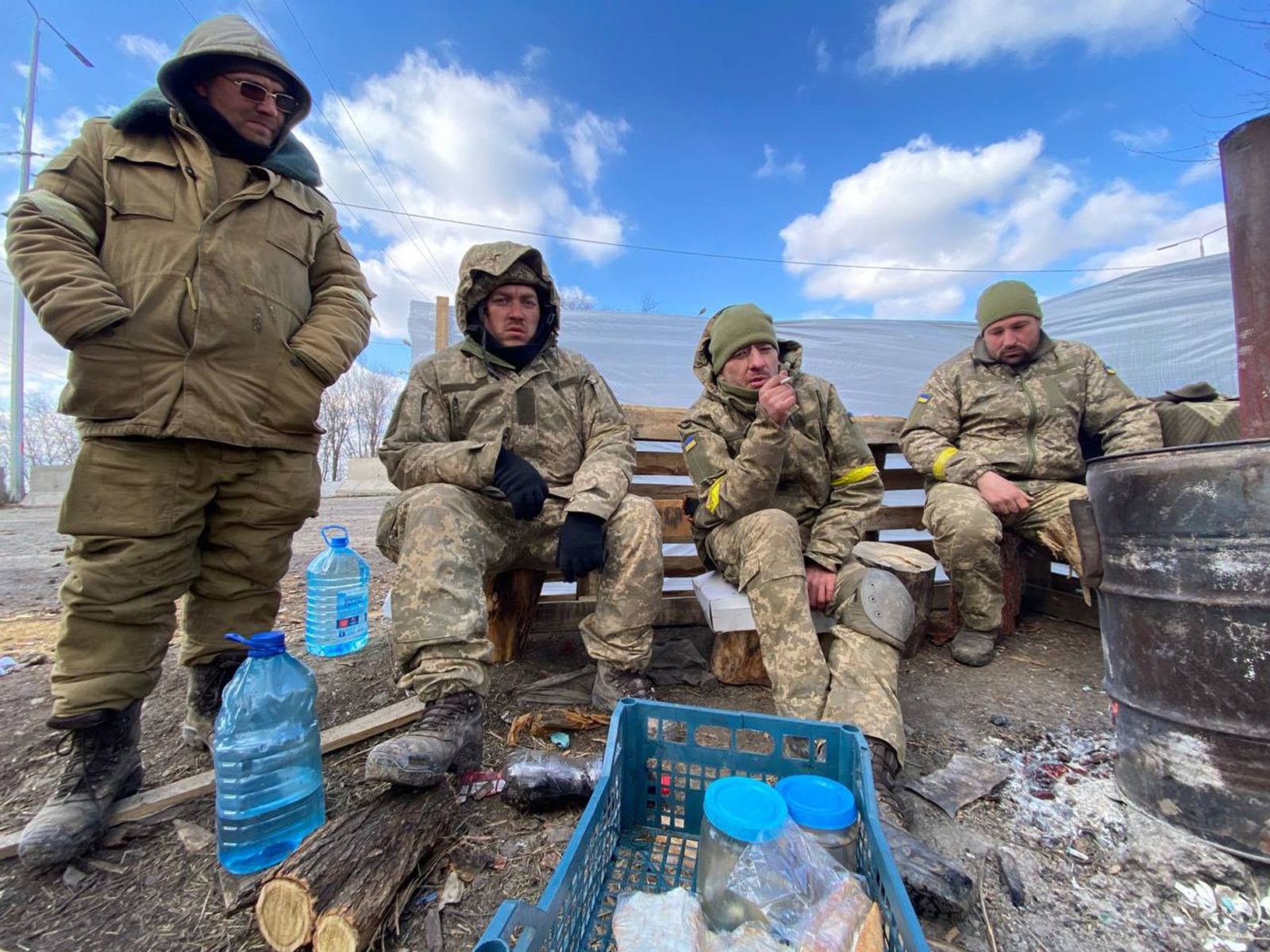
Ukrainian military
Elena Kostyuchenko / Novaya Gazeta
“We keep saying: ‘Russians, go home! Just go home, that’s it. We didn’t ask you to come here. You don’t have to die here.’”
“Why won’t they collect their corpses? They’re just fertilizer for our fields. So sorry, but your son will come here and you’ll never see him again, no neat little grave for you to visit. Something happens to me, though, my mom will grieve for me and bury me herself.”
“People who used to be like brothers to us are our enemies now, because they attacked us—that’s not what brothers do. We have to defend our land, we have to stand our ground. We didn’t want this war, we didn’t see it coming.”
“I’m from Mykolaiv myself. Am I supposed to just sit home and wait? I went down to the recruitment office on the very first day.”
“We don’t want to wage war against Russia. So don’t you come and wage war against us.”
“They think Ukraine is weak. No. Ukraine is really good. We know every hole and every burrow here. This is our land you’ve come to.”
“We don’t want war. We want you to leave us alone.”
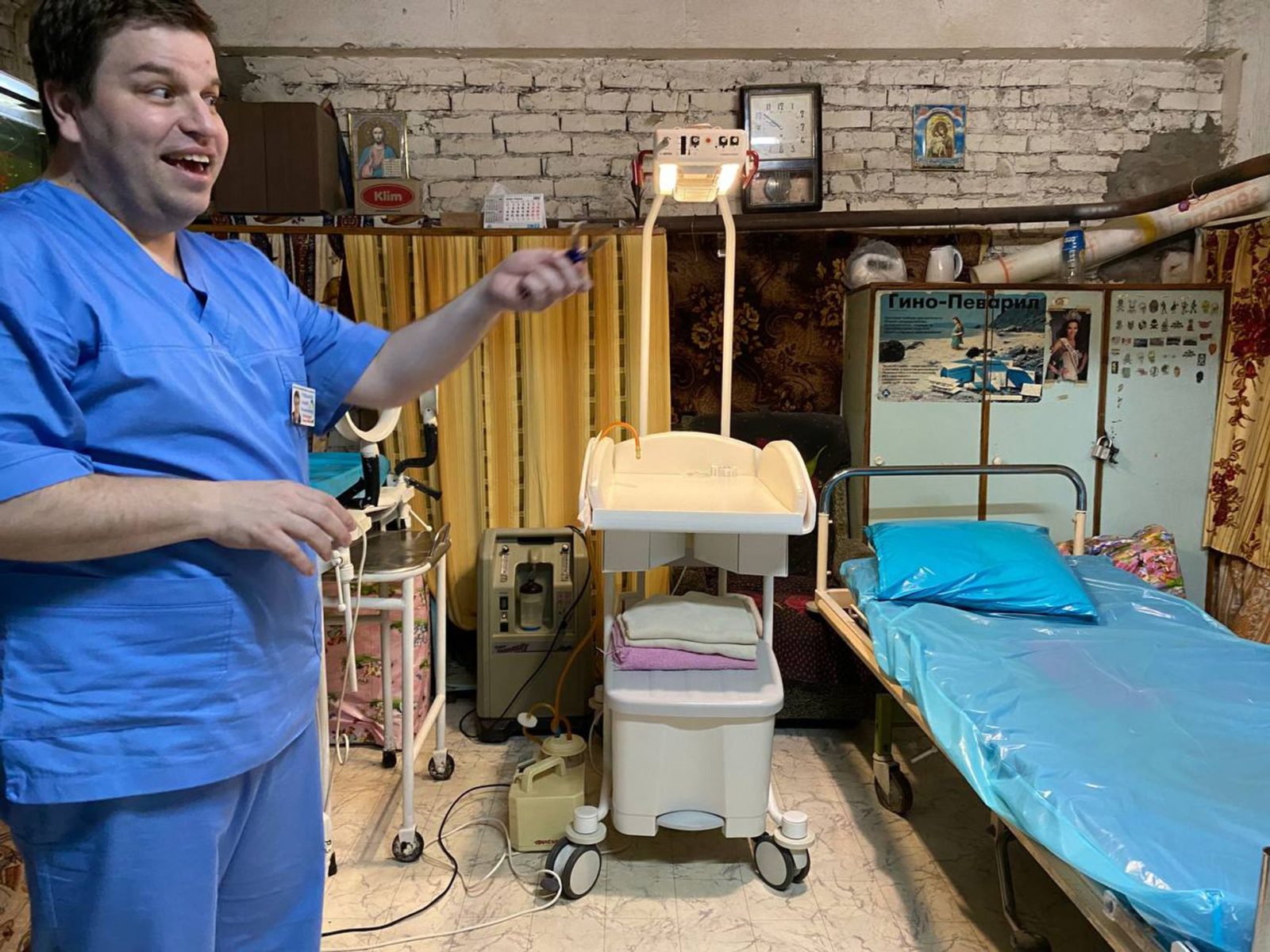
Maternity room in the basement of maternity hospital No. 3
Elena Kostyuchenko / Novaya Gazeta
So far, twenty-two babies have been born at the Mykolaiv maternity hospital No. 3 during the war, two of them in the makeshift bomb shelter in the basement. All of the babies survived.
There are almost no C-sections anymore, because the stitches need rest, peace, and quiet, and there’s no peace now, not with the air raids. A maternity ward has been set up in the basement, but the operating rooms are still on the third floors. This is very dangerous. A siren blares. Expectant mothers walk down to the basement, step by step, holding on to the walls, their descent slow and ponderous. The midwives carry the babies down.
Lena Sylvestrova lies on a metal gurney under a woolen blanket. Her husband, Aleksei, is trying to soothe her. The palm of his hand is on her neck. Lena gave birth at 4:30 a.m. by C-section. She had tried for a natural birth, she labored for almost twenty-four hours. She is twenty-eight and her husband is twenty-six. This is their first child. She went into labor early in the morning, after curfew. Aleksei drove her to the hospital himself.
“My due date was just around when the war started. I was so worried, waiting for it all to kick off. I was constantly on edge, waiting. Worrying that we’d get caught in an air raid or shelling in town. I was lucky—they managed to do my C-section between two air raid sirens. Imagine, you are in labor, all you want is some peace and quiet for your baby, but instead, your city is being endlessly bombed!”
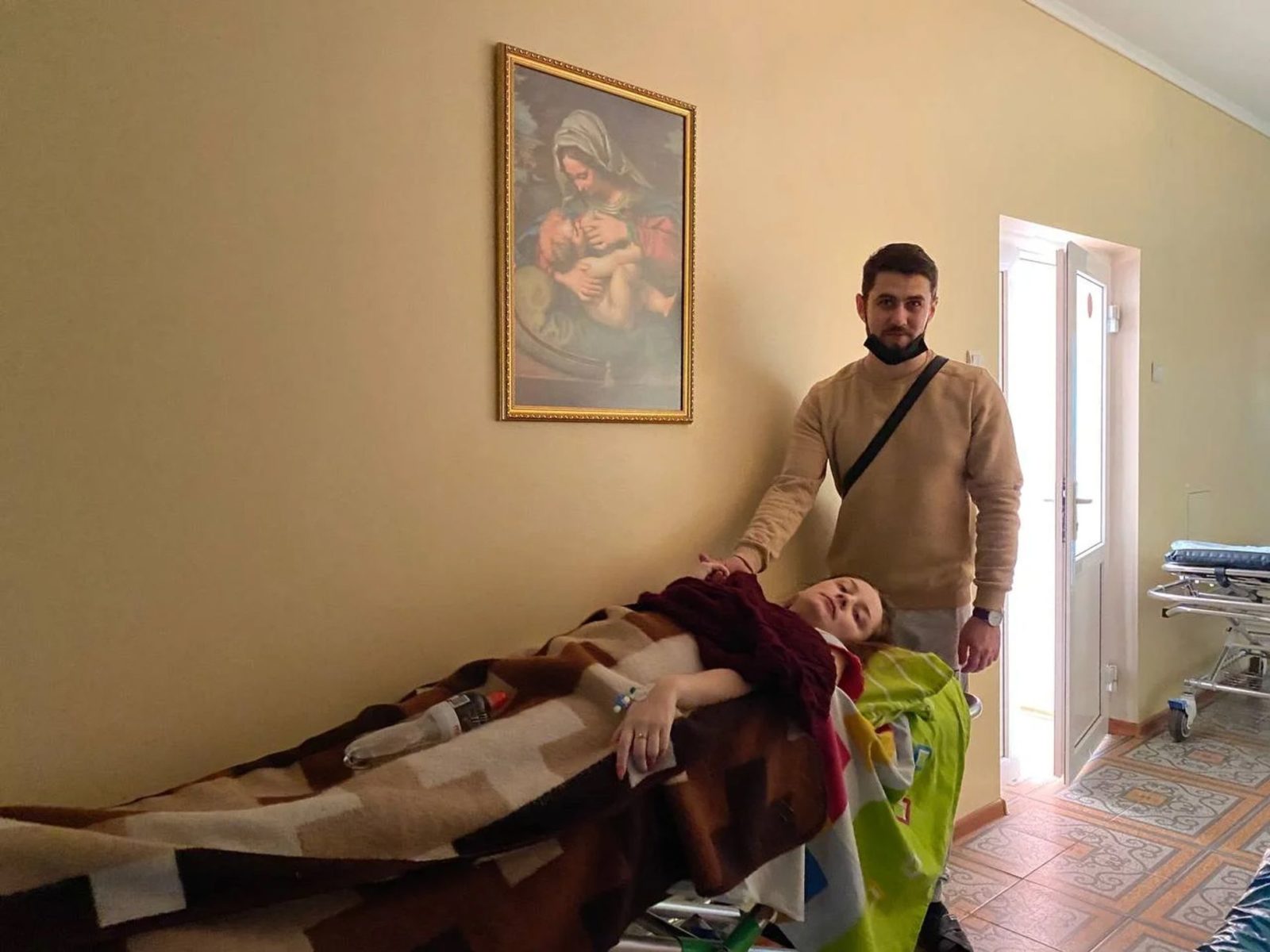
Alexey and Lena, a young mother
Elena Kostyuchenko / Novaya Gazeta
Aleksei strokes her cheek.
“I’d love to remember what it’s like, walking around without worrying about getting shot.”
The light in the basement is dim, the women sit along the walls. The chief physician takes Aleksei to the archive department and quietly opens the door. Inside, a midwife sits on some mattresses and cradling a white bundle. She holds the bundle out toward Aleksei. “I don’t want to hold it, I’m scared,” he tells her.
“Better get used to it. Don’t be scared, nothing to be afraid of.”
Aleksei holds Masha in his arms. It’s his first time. The midwife gently adjusts his hands.
“She’s so tiny,” Aleksei says. He falls silent, his face dipping ever closer to his daughter’s. “My little girl. Hello there! Are you sticking your tongue out at me? Really, Masha? We’re going to be together every day, every single day, deal?”

Alexey and newborn Masha
Elena Kostyuchenko / Novaya Gazeta
We only want peace. Please write that,” says a woman in a white lab coat. “My name is Nadezhda Sherstova. I’m a senior nurse anesthetist. I’ve been doing this job thirty years. Since the war started, whenever a baby is born, there’s no joy in the parents’ eyes. You worry about the mothers, their milk coming in. That’s what scares me. There is no joy for the parents.”
“She was a real pain,” Aleksei tells the chief physician. “Constantly kicking. She’d hear my voice and start in on her dancing in there. Wouldn’t let her mom sleep at night. She’s kicking a little right now. I thought she would look like me. When we did the ultrasound, they said she looked like me, but look how pretty she is.”
The next shelling of Mykolaiv began at 8:00 p.m. on March 11 and lasted most of the night, with brief pauses. According to Mayor Oleksandr Senkievich’s official statement, more than 167 residential buildings sustained damage, including City Hospital No. 3 (which was filled with wounded civilians), a prepared-food plant, eleven schools and day cares, and an orphanage. Eleven private homes were completely destroyed. Shrapnel shredded the yard of the cancer ward and the emergency department. Kuzya, the beloved hospital guard dog, was killed. They covered him up with a towel. The cemetery was shelled, too. Fires have broken out all over the city.
Woman’s body, man’s medicine
Our starting point is an androcentric medicine that has investigated manifestations in men and extrapolated the results to women.
It was thought that reproductive health was the only differentiating characteristic, but the symptoms, treatments and recovery for the same disease might not be the same.The biological differences, which are often invisibilised, explain only part of the health inequalities, which are also conditioned by gender roles.
The following are some of the specific characteristics of women’s health
- Mental health
- Cardiovascular disease
- Respiratory diseases
- Breasts
- Reproductive system and sexuality
- Joints
- Autoimmune diseases
- Research and drugs
1. Mental health: From mixed bag to overmedication
More cases of depression and anxiety
Worse living and working conditions for women, double working days (particularly for less qualified workers), domestic and care work, guilt and perfectionism can all have an impact on women’s health. Women are more likely to experience mental health problems such as anxiety and depression, which affect almost twice as many women (13.7%) as men (7.4%). Moreover, one in three women says they feel emotional distress, while in men this figure is one in five.
“It’s a mixed bag. Anything that happens to a woman is attributed to her being anxious or overstressed, without taking into account her working or care conditions. A pill isn’t the solution. We have to change living and working conditions.”
Carme Valls, Endocrinologist and author of Mujeres Invisibles Para La Medicina
More anxiolytics
Women are more likely to be sent away with a diagnosis of mental illness at an initial visit than men; in the latter, an organic cause is immediately suspected and additional tests are requested. This gender bias leads to overmedication in women: 85% of psychotropic medications are administered to women. This overdiagnosis can also render invisible physical diseases that are hidden behind an incorrect diagnosis of mental illness or psychosomatic symptoms because they might not fit the “normal pattern,” i.e. the male model.
The taboo of motherhood
Another area ignored by science is mental health and motherhood. One in four women experience some kind of mental health problem, some more severe than others, during pregnancy or in the postpartum period, and most of them are not treated. This is not helped by the fact that the postpartum and nurturing period is a lonely time for many women. Traumatic childbirth, a difficult pregnancy, childhood trauma or stressful situations can trigger postpartum depression and the most common symptoms are sadness, hopelessness, emotional changes, insomnia or difficulty bonding with the infant.
2. Cardiovascular disease: Heart attacks are mistaken for anxiety
Leading cause of death
Cardiovascular disease is the leading cause of death in women in Spain, ahead of breast cancer. While men experience more heart attacks and women more strokes and heart failure, women are twice as likely to die in the event of a heart attack. The mortality rate of myocardial infarction is 9% in men and 18% in women. There are various reasons for this. It takes women longer to go to the hospital and their symptoms are often mistaken for anxiety.
“Cardiovascular diseases are very well differentiated in men, but in women, the diagnosis is much less specific and less cautious than in men. Fewer tests are carried out, assuming ‘the chest pain must be anxiety’. No. At the very least an electrocardiogram, imaging study or stress test must be performed to rule out an organic cause.”
Antonia Sambola, Cardiologist at Vall D’Hebron Hospital and expert in women’s cardiovascular health
Delayed diagnosis
Women seek care later, downplaying their symptoms or putting the care of others before their own, and this leads to delayed diagnosis. The symptoms are also confusing at times. Chest pain is a symptom in 90% of women, but they also have other additional symptoms, which are more intense than in men, including nausea, vomiting, dizziness and headache. “They also have chest pain and shortness of breath, like men, but by the time women go to the doctor the chest pain has already passed because they are already in heart failure,” adds Sambola.
More research
Practitioners are calling for more emphasis on cardiovascular disease prevention as there are risk factors in women that are largely left unaddressed and that are closely related to pregnancy and childbirth, such as preeclampsia, gestational diabetes and premature birth. “Menopause also increases cardiovascular risk. Has that been explained? There isn’t enough information. We’re completely lost,” acknowledges Elisa Llurba, Head of the Gynaecology Department at Sant Pau Hospital. Practitioners also call for campaigns to promote self-care.
3. Breasts: Between aesthetics and pathology
Aesthetic pressure
Breasts have been used to sell everything from cars to perfumes, but we have rarely studied what they look like on the inside. The breast has not been studied from an anatomical or physiological perspective. “It has become trivialised as something which is aesthetic rather than functional, and we have gone from not knowing anything about breasts to knowing only their pathology, breast cancer,” says surgeon Maria Jesús Pla. Furthermore, the depiction of a perfect breast has failed to take into account the fact that they come in all shapes and sizes. “The mammary gland is neither seen nor explained. We don’t know how it works, but they do teach us how the liver and kidneys work. Most women don’t know what the raised bumps on the areola of the nipple are called,” adds breastfeeding expert Alba Padró.
Breastfeeding
Over 90% of women who give birth breastfeed their children in the first few days, a percentage that decreases as time passes. There are multiple reasons for this, ranging from insufficient leave from work to a lack of breastfeeding support.
“Healthcare professionals do not receive specific training on breastfeeding and the training they do receive is not enough. Much emphasis has been placed on the benefits, a chapter that has since been closed, but not on the solution to the problems. You would expect paediatricians to be trained in breastfeeding but they’re not, and this is the first reality check: breasts are essentially no one’s territory.”
Alba Padró, Cofounder of LactApp and IBCLC breastfeeding expert
Breast cancer
Approximately one in every eight women will develop breast cancer in their lifetime. It is the most common tumour in women worldwide and in Catalonia, it accounts for about 30% of the tumours affecting women. Most cases are diagnosed between the ages of 35 and 80, with the highest number of cases between the ages of 45 and 65. The disease also has an emotional impact that other cancers might not have, as it is a more visible organ and has sexual and aesthetic implications. The challenge for these patients is to return to their work and sexual life.
“Surgeons must be sensitive to the aesthetics of the breast because tumours here have special implications. Conservative surgery rates are very high, at over 75%, and when this isn’t possible, immediate reconstruction is performed. You shouldn’t end up with a line. But it’s also important to remember that a woman is more than just two breasts.”
Maria Jesús Pla, Breast surgeon at Bellvitge Hospital
Controversial mammograms
Survival rates have increased with the improvement in treatments, as this is a tumour that is subject to a lot of research and early detection through population screening. In Catalonia, mammograms are recommended between the ages of 50 and 69 every two years, not annually. Routine mammograms are not recommended in women under the age of 50 with no risk factors. The effectiveness of screening in women between the ages of 40 and 49 is a controversial debate. “The disease is less prevalent and mammograms are less effective. If population screening were to be extended, it has been said that it would be better to do so amongst women between the ages of 70 and 75,” explains Maria Jesús Pla.
4. Respiratory Disease: Conditions on the rise among women
Lung diseases
Respiratory diseases that were considered to be predominantly male conditions have risen among women due to the increase in smoking. This is the case for chronic obstructive pulmonary disease (COPD), which, according to a study by the Hospital del Mar, shows more symptoms in women: increased breathlessness, increased muscle involvement and more lesions than in men with equally severe disease. COPD is a disease that is underdiagnosed in women. According to Carme Valls, there is a tendency to diagnose women with asthma when in actual fact it is COPD. Practitioners believe it progresses differently not only because of the biological characteristics of sex but also because of the sociocultural characteristics of gender. Women with this disease have a worse quality of life.
Lung cancer
Lung cancer, which is the leading cause of cancer death, is also on the rise among women due to the increase in smoking. It has gone from being the fourth most common tumour among women in 2015 to the third, and it is expected to continue increasing in the coming years, overtaking breast cancer. Meanwhile, it is expected to become less common among men due to the decline in smoking.
“Lung cancer used to be considered a male disease and this has likely led women to be less cautious with smoking. Perhaps there should be gender-specific public health campaigns aimed at women and young girls.”
Enriqueta Felip, Head of the thoracic, head and neck cancer unit within the oncology department at Vall D’Hebron Hospital
Long COVID
There are people, mostly women, who have already had an acute coronavirus infection but continue to have symptoms six months later. These are generally young women, between the ages of 35 and 50, who have a wide range of fluctuating symptoms including headaches, extreme fatigue, tachycardia, muscle and joint pain, breathing difficulty and memory loss. This even occurs after having had a mild form of COVID. The symptoms are similar to those of chronic fatigue, a condition with which they also share preconceptions and a lack of understanding. Long COVID is thought to affect between 10% and 20% of patients. There has been a lack of information on this condition for months, which has led to underdetection and those affected have at times felt questioned by the healthcare system.
5. Reproductive system and sexuality: Invisbilised diseases and the medicalisation of physiological processes
Silenced disease
There are diseases that only affect women, such as endometriosis, for which there is a lack of investment and research because, as scientist Maria Montoya from the Spanish National Research Council (CSIC) ironically puts it, “they only affect 50% of the population.” Endometriosis is the gynaecological disease with the highest incidence: it affects at least 10% of women of reproductive age, but this figure could be higher as the condition is underdiagnosed. It is a chronic disease, and its best-known symptoms are pain during menstruation, pelvic pain and infertility. However, the pain has become socially normalised among women to the point that a diagnosis can take up to eight years.
Obstetric violence
The healthcare system has medicalised normal physiological processes in women, such as pregnancy, childbirth and menopause, by imposing a paternalistic approach: seven out of ten women say they have felt belittled during pregnancy or childbirth. However, women are becoming increasingly informed and empowered and are pushing for a change in the care model, demanding more humanised and less medicalised care. “Depending on how we deal with childbirth, we can leave a young, healthy woman with a chronic condition, and the healthcare system and practitioners must be held accountable for this,” says Maria Llavoré, a midwife at Sant Pau Hospital.
“We are being self-critical. There is an element of unconscious structural violence, and the sooner we accept this, the sooner we can fix it. There’s no point in becoming bogged down in whether or not to call it obstetric violence. We can and must do better.”
Elena Carreras, Head of obstetrics at Vall D’Hebron Hospital
The caesarean section rate in Catalonia (27.4%) is still double the WHO’s recommended rate (15%) and is, together with inductions, an indicator of obstetric quality. Episiotomies, the Kristeller manoeuvre and overmedication are just some of the practices that have been criticised. But infantilising a woman or disregarding her consent is also considered to be obstetric violence. This respect applies not only to childbirth but also to miscarriages, abortions and infertility or assisted reproduction procedures. The Ministry of Equality, like the Catalan law on gender-based violence before it, plans to include obstetric violence as a form of violence against women in the reform of the abortion law. The Catalan Society of Obstetrics and Gynaecology and the four Catalan medical associations have recently acknowledged that obstetric violence exists and are calling for a debate, even though they have admitted that the term makes them uncomfortable.
Sexuality
Female sexuality has been invisibilised or is full of taboos and stereotypes, and pleasure and the female body have long been an unknown reality, even to women themselves. We have not received sex education, and the education we have received has perpetuated sexist models. However, more and more women are reclaiming their pleasure while making sexual and gender diversity visible beyond binarism. Beyond this, consultations related to sexuality are increasing because issues such as pain during sex and anorgasmia are no longer normalised.
“The level of ignorance about women’s bodies is appalling, even among some practitioners. The clitoris hasn’t been studied, it’s unknown, it’s not drawn and it doesn’t appear in photos. If we don’t talk about it, it doesn’t exist. If women don’t know where it is, they don’t know where to stimulate it.”
Maria Llavoré, Midwife at Sant Pau Hospital
Pelvic floor
Almost half of women (46%) have one or more pelvic floor disorders, such as urinary or bowel incontinence or pelvic organ prolapse. This has a major impact on their quality of life. Pregnancy and childbirth are key factors, but there are also other causes such as high-impact sport, constipation, ageing and menopause. Until recently, it was considered that, since no one died, it was simply accepted, but practitioners are calling for check-ups and treatment of the pelvic floor to be routine practice in the healthcare system and for there to be a prevention strategy: the pelvic floor should be discussed from an early age, and training should be provided in schools. Teaching how to do Kegel exercises should be like teaching them how to brush their teeth.
Gynaecological cancers
These cancers begin in the female reproductive system. They can affect the cervix (the neck of the uterus), ovaries, uterus, vagina and vulva. The risk increases with age and some gynaecological cancers are caused by the human papillomavirus (HPV). Girls and women between the ages of 9 and 26 can be vaccinated against HPV, and vaccination is recommended before becoming sexually active. If the vaccine were less expensive, practitioners believe that it would also be advisable to administer it to boys.
6. Joints: Women’s pain: an unresolved issue
Chronic pain
One in three women reports having pain or discomfort, while in men this figure is one in five. Women are more likely to experience chronic pain as most diseases that cause muscle or joint pain are more common in women. “Chronic pain is one of medicine’s unresolved issues,” says endocrinologist Carme Valls. Experts are calling for it to be addressed as a public health problem.
“It is important for healthcare professionals to consider not only the disease but also what comes before it: the living conditions that may have led to these disorders. Including the gender perspective is an improvement in care. You can’t take care of people’s health without taking into account their living conditions, which are very different for men and women.”
Lucía Artazcoz, Director of the Public Health Observatory of the Barcelona Public Health Agency
Physical and mental overload
Rheumatic and musculoskeletal diseases such as arthritis, osteoarthritis, back pain, osteoporosis and fibromyalgia are common causes for consultation in primary care. It is estimated that these conditions take up around 30% of primary care physicians’ time. Valls states in her text that the pain of many women is often silenced or rendered invisible with psychotropic medications and that studies do not take into account the physical and mental overload experienced by women in their lives and workplaces.
Fibromyalgia
Fibromyalgia is characterised by chronic pain throughout the body, particularly in the muscles and joints of the back and limbs, and hypersensitivity to pain, noise, smells and light. It can also be accompanied by cognitive and sleep disorders, gastrointestinal disorders and fatigue. It is a disease that occurs more frequently among women (4.2% of women and 0.2% of men in Spain), its origin is unknown and, in many cases, it is debilitating. Those affected can spend years going from one consultation to the next until eventually reaching the diagnosis of a highly stigmatised disease.
“The prevalence among women is huge. There are no doubt hormonal and pain perception factors involved, but we’re not really sure about this. What we do know is that the pain exists and that they’re not making it up. There are some very hard-hitting cases. What is the cause? That is up for debate, but the pain is real.”
Josep Blanch, Head of the Rheumatology Department at Hospital Del Mar
It is not without controversy. Carme Valls wrote in her text that “all kinds of muscle pain for which no explanation could be found have been attributed to this disease, with no objective evidence.” She questions the fact that it is treated with psychotropic medications and believes that more research studies are needed for women diagnosed with fibromyalgia.
7. Autoimmune Diseases: Complex diseases that affect women the most
Attacked by our own defences
Autoimmune diseases are those in which the immune system attacks the body’s own organs. It is estimated that one in ten people in Catalonia has an autoimmune disease. Some only attack specific organs, such as autoimmune thyroiditis, the most common form, which affects the thyroid gland, while other systemic forms involve a generalised attack. Sjögren’s syndrome is the most prevalent of these, but lupus is the most paradigmatic.
More women affected
Two-thirds of those affected are women and in some specific conditions this proportion is even larger: for every man with lupus there are nine women, and for every man with Sjögren’s syndrome there are six women. There are multiple reasons for this, but female sex hormones are a major factor, and “periods in which they are more active, from puberty until menopause” is when the most disease onsets and the most flare-ups occur.
“In the case of lupus, treating the kidney or nervous system is just as important as treating reproductive issues or skin lesions on the face, something that perhaps would not be as important for a man.”
Ricard Cervera, Head of Autoimmune Diseases at Clinic Hospital
Pregnancy
It also affects women of childbearing age, which has special implications. Forty years ago it was said that women with lupus would not be able to have children as they would miscarry and the disease would flare-up. Nowadays, they have similar fertility to the general population and pregnancies are more closely monitored.
The other bias
In this case, it is men who may experience a delay in diagnosis because, in theory, doctors find it hard to believe that a man might have lupus, for example. But when they do have it, it is more severe.
8. Research and Drugs: The effect of excluding women from clinical trials
Clinical trials
For decades there has been gender bias in clinical research. Due to hormonal changes and for safety reasons, women are often not included in clinical trials and this exclusion has led to gaps in knowledge. This is also the case for studies with non-human animals, in which two-thirds are male. When women have been included in trials, the results have not been segregated, meaning that the results are applied equally to both men and women, even though the participation of women is lower. “When you don’t segregate by sex, you don’t know the situation for either men or women, or the specific characteristics of each of them, and that’s bad science,” notes Lucía Artazcoz. But this is changing, partly thanks to COVID.
“Men and women react differently to the coronavirus and this must be taken into account. The disease is teaching us not to treat patients as a homogeneous entity and we can all benefit from this, as it enables us to adjust treatments or medication doses.”
Maria Montoya, Head of the viral immunology group at the Margarita Salas Centre for Biological research of the Spanish National Research Council (CSIC)
Adverse reactions
Excluding women from clinical trials means that adverse drug reactions are either unknown or take years to be noticed and for measures to be taken. Eight out of ten drugs withdrawn from the market in the USA between 1997 and 2000 had greater health risks for women than for men. As an example, statins, a widely used drug, have been shown to have more adverse effects on women.
The way in which the drug is metabolised or how we benefit from the drug is different due to metabolic and genetic history as well as hormonal issues. Again, there is little information available, or incomplete information, regarding the adverse effects of drugs on pregnant and breastfeeding women, and the coronavirus vaccine is an example of this. The information on COVID in pregnant women has been contradictory since the start of the pandemic.
“In oncology, chemotherapy is administered according to body surface area and this does not take into account the differences in body composition between the sexes. The patient’s sex also affects the absorption, distribution, metabolisation and excretion of drugs.”
Dorothea Wagner, Head of the Gastrointestinal Cancer Unit at Lausanne University Hospital
Dosage
It has been assumed that if a dose is appropriate for a man, it is also appropriate for a woman, but men and women are different in many respects, one of which is body mass. For example, men have 80% fat-free body mass and women have 65%, and this affects the way in which we metabolise a drug.
In oncology, “the same drug may be less effective or ineffective in one sex compared to the other, and we might have to use different drugs depending on whether the patient is a man or a woman,” Wagner adds. But this also poses a challenge because sex is not the only factor involved in the variability of responses to a drug. To this end, practitioners are calling for more clinical trials and the inclusion of non-binary genders, too.
Contraceptive pills
To downplay the risks of thrombosis of the AstraZeneca vaccine, they were compared to those of contraceptive pills, which are more common, and no one was surprised. Without criminalising contraceptives, which were a liberation for women, women are demanding that they be provided with full information about side effects. The risk of thrombosis is estimated to be 1 to 10 in every 10,000 women, making it a rare adverse effect, but we must be aware of the factors that may favour it, such as family history, being over 35, smoking, excess weight and hypertension. The other most common side effects include mood disorders, reduced libido, migraines, nausea and fluid retention. They are also prescribed for other conditions such as polycystic ovaries and endometriosis, and this may lead to other possible solutions not being investigated.
“Over time, instead of investigating any small changes in the regularity of the menstrual cycle or in the intensity of menstruation to diagnose the causes, they have been initially treated with normal contraceptives.”
Carme Valls, Endocrinologist and author of Mujeres Invisibles Para la Medicina
The pills are said to “regulate the cycle,” but in actual fact they inhibit it. With contraceptives, there is no real bleeding because there is no ovulation. It is fictitious bleeding because during the break there is a sudden hormonal change. This is meant to mimic the female cycle because it is a way of reassuring women, but it is not really menstruation, although many women do not know this. “Why the male contraceptive pill has never been marketed is a matter for further reflection,” writes Valls. As for the relationship between contraceptives and breast cancer, there is much controversy and there are no conclusive studies, although Pla assures that “it has not been proven to be a risk factor.”
Menopause
On the other hand, hormone replacement therapy (HRT) with oestrogens and progestin, which is used to alleviate some of the effects of the menopause, such as vaginal dryness and hot flushes, has been linked to an increased risk of breast cancer and women are advised against receiving it for over five years. According to a 2004 study, 43% of women who were prescribed this were unaware of the risks involved in its use.
“Menopause research is needed. I have found very few studies on this and every practitioner has different answers. Natural or artificial methods? There is no clear evidence. We’re in limbo. Have women been asked what concerns they have about this stage? Because the needs of women nowadays are not the same as 25 years ago.”
Elisa Llurba, Director of the Gynaecology and Obstetrics Department at Sant Pau Hospital
9. Conclusion
No more, no less.
Just different
The paradox when we talk about gender and health is that women live longer but have a poorer quality of life. “They have diseases that don’t kill them, but they don’t let them live,” according to public health specialist Lucía Artazcoz. Socialisation and gender roles condition our health. Primary care practitioners see this on a daily basis. “When you ask women what makes them suffer, you see that we all have a shared experience that has an impact on our health,” explains Meritxell Sánchez-Amat, a general practitioner at Besòs Primary Care Centre, who is calling for more time per patient and more home visits to allow for a psychosocial approach, as “drugs are the quick and easy answer”. She believes that introducing the gender variable would help avoid medicalisation and overdiagnosis.
“But it’s difficult. It means going against the tide. As practitioners, we are part of this patriarchal society, and as a healthcare institution we are not self-critical.”
Meritxell Sánchez-Amat, General Practitioner and President of the Catalan Forum for Primary Care (FOCAP)
Gender-sensitive medicine and research are also closely related to the fact that there are more women in leadership and decision-making positions. “It is essential to change the way we look at things,” says cardiologist Antonia Sambola. Gynaecologist Elisa Llurba, who is calling for the Catalan public broadcaster to dedicate an edition of its annual TV3 telethon exclusively to women’s health, admits that she was previously unaware of this gender bias. “I didn’t see it until now, because I considered many practices to be normal and I hadn’t understood them from that perspective.” According to fellow gynaecologist Elena Carreras, “gender bias in medicine exists, and as soon as you become aware of it, it’s no longer an option to do nothing.” This benefits men as well as women, “because this outlook makes us question whether we are doing it right.” While women are overdiagnosed with mental health problems, men are underdiagnosed with depression, fibromyalgia and osteoporosis, which are more common in women. This approach should also be taken on at universities and in the continuing education of healthcare professionals.
Including sex is not enough
To break this bias, it is not enough to include the sex variable alone. We must also include that of gender. “We just assume that a patient is male or female, but there are individuals who are intersex. We also assume that patients are cisgender – when gender identity matches the sex assigned at birth – but we must move away from assuming and start asking. We need to be more empathetic with gender identities because this strengthens the science,” said Ewelina Biskup, Professor at the Shanghai University of Medicine and Science, at a conference on gender-sensitive medicine held at Vall d’Hebron Hospital. This is the first hospital to have created a health and gender committee, and the Department of Health plans to extend this to all centres to incorporate this approach into healthcare practice. As Artazcoz says, “we are still a long way from gender-sensitive medicine”, and the first step is to stop using men as a benchmark. “Women’s health is no more and no less than men’s health. It’s just different.”

